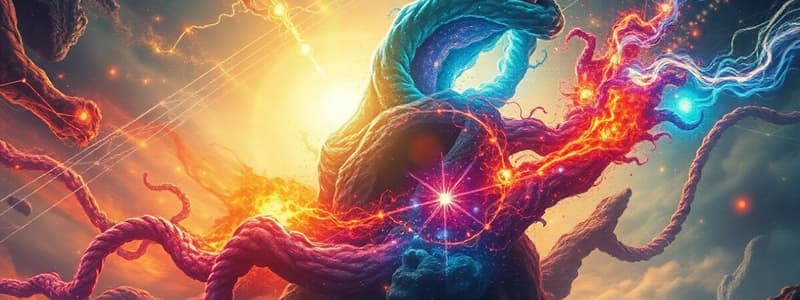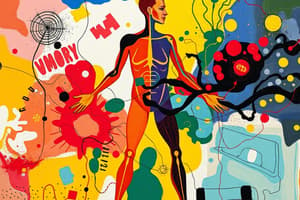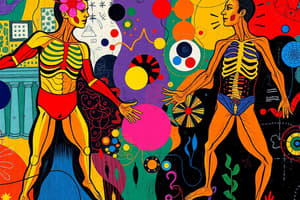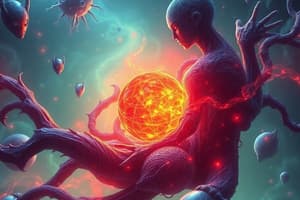Podcast
Questions and Answers
What is the primary role of ATP during muscle contraction?
What is the primary role of ATP during muscle contraction?
- It acts as a catalyst in nutrient catabolism.
- It is converted to ADP and releases energy. (correct)
- It binds to phosphorus to create energy.
- It is stored as a reserve energy compound.
What process involves the conversion of ADP to ATP in the presence of oxygen and the electron transport chain?
What process involves the conversion of ADP to ATP in the presence of oxygen and the electron transport chain?
- Oxidative phosphorylation (correct)
- Substrate-level phosphorylation
- Lactic acid cycling
- Fermentation
Which of the following is NOT an energy-rich compound mentioned in the context?
Which of the following is NOT an energy-rich compound mentioned in the context?
- 1,3-BPG
- Creatinine phosphate
- ATP
- Glucose (correct)
During catabolism, which coenzymes are reduced to collect electrons?
During catabolism, which coenzymes are reduced to collect electrons?
How does substrate-level phosphorylation differ from oxidative phosphorylation?
How does substrate-level phosphorylation differ from oxidative phosphorylation?
What is the primary role of ATP in metabolism?
What is the primary role of ATP in metabolism?
Which metabolic process primarily involves energy-requiring biosynthesis?
Which metabolic process primarily involves energy-requiring biosynthesis?
What characterizes catabolic reactions in metabolism?
What characterizes catabolic reactions in metabolism?
What is the consequence of the negative charges on phosphate groups in ATP?
What is the consequence of the negative charges on phosphate groups in ATP?
What is a characteristic of metabolic pathways?
What is a characteristic of metabolic pathways?
How is ATP primarily generated in cells?
How is ATP primarily generated in cells?
Which of the following best describes endergonic reactions?
Which of the following best describes endergonic reactions?
What does the ATP-ADP cycle primarily involve?
What does the ATP-ADP cycle primarily involve?
Flashcards
ATP in Muscle Contraction
ATP in Muscle Contraction
ATP is used by muscles to contract. It's broken down into ADP and Pi.
Energy-Rich Compounds
Energy-Rich Compounds
Compounds that release energy when broken down (hydrolyzed). Examples include ATP, PEP, 1,3-BPG, and creatine phosphate.
Substrate-Level Phosphorylation
Substrate-Level Phosphorylation
A metabolic reaction that creates ATP by transferring a phosphate group from a high-energy compound.
Oxidative Phosphorylation
Oxidative Phosphorylation
Signup and view all the flashcards
Catabolism
Catabolism
Signup and view all the flashcards
ATP
ATP
Signup and view all the flashcards
ATP-ADP cycle
ATP-ADP cycle
Signup and view all the flashcards
Endergonic reactions
Endergonic reactions
Signup and view all the flashcards
Exergonic reactions
Exergonic reactions
Signup and view all the flashcards
Coupled reactions
Coupled reactions
Signup and view all the flashcards
Study Notes
Overview of Metabolism
- Metabolism is the set of enzyme-catalyzed transformations of organic molecules in living cells
- Living cells and organisms perform work to stay alive, grow, and reproduce
- Organisms carry out diverse energy transductions (conversions of one form of energy to another)
- Organisms utilize chemical energy from fuels (food) to synthesize complex molecules and maintain gradients
- ATP is a crucial energy-rich compound
Anabolism and Catabolism
- Anabolism is the energy-requiring biosynthesis of cell components from smaller precursors, typically a reductive process
- Catabolism is the energy-yielding degradation of nutrient molecules, typically an oxidative process
Basic Principles Governing Energy Manipulations in All Cells
- Molecules are degraded or synthesized in metabolic pathways
- Some pathways release energy, others require it
- ATP is the energy currency of life, supplying and storing energy for pathways that need it, or being produced by pathways that release energy
- ATP is formed through the oxidation of carbon compounds, including glucose and fatty acids
- Metabolic pathways are highly regulated by regulatory enzymes
ATP - Adenosine Triphosphate
- ATP is the energy currency of cells
- Links catabolism and anabolism
- Structure: Adenine (nitrogenous base) + Ribose (carbohydrate) + 3 phosphate groups
- Phosphate groups carry negative charges, leading to instability and spontaneous hydrolysis, releasing energy
- ATP cycle involves phosphorylation (adding phosphate to ADP) and hydrolysis (removing phosphate from ATP)
- ATP is replenished through the metabolism of nutrients in catabolism
How ATP is Synthesized
- Substrate-level phosphorylation is a quicker, less efficient method of ATP synthesis that happens in the absence of mitochondria or anaerobic conditions occurring when energy from another high energy bond phosphorylates ADP to ATP
- Oxidative phosphorylation, via the ATP synthase, is the most frequent source of ATP, that occurs in mitochondria through aerobic respiration
Catabolism Overview
- Catabolism is the oxidative process where substrates lose electrons
- Oxidize coenzymes (NAD+ and FAD+) collect and reduce electrons (NADH and FADH2), that are transferred to the electron transport chain to form ATP
- Different nutrient molecules (lipids, carbohydrates, and proteins) enter catabolic pathways and are broken down to release energy.
Oxidation-Reduction (Redox) Reactions and Coenzymes
- Redox reactions involve the transfer of electrons from a donor to an acceptor
- Oxidation is the loss of electrons, reduction is the gain
- Coenzymes (NAD+, FAD+) participate in redox reactions by accepting and donating electrons in catabolism and anabolism
Energy- Rich Compounds
- ATP is not the only energy-rich compound.
- Other compounds like Phosphoenolpyruvate (PEP), 1,3-Bisphosphoglycerate (1,3-BPG), Creatine phosphate and others can be hydrolyzed to release energy which can, in turn, be used to resynthesize ATP.
Studying That Suits You
Use AI to generate personalized quizzes and flashcards to suit your learning preferences.




